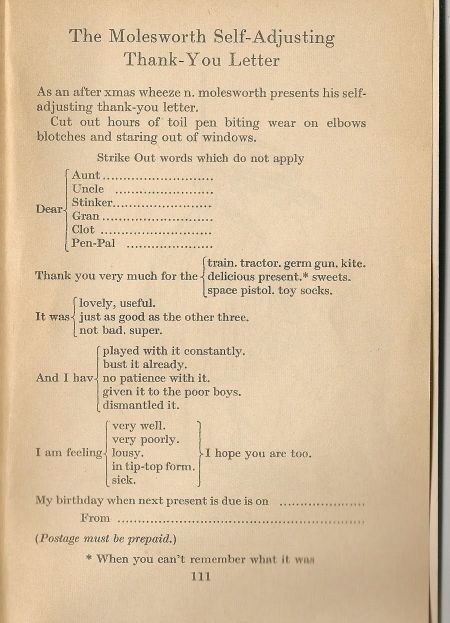Molesworth self-adjusting thank-you letter

|
When thought leader Darryll R. Mountain predicted[1] that document assembly would lay waste to the legal profession a few years ago, he can not have known how late to the party he was. For the forefather to this vision was the noble, fearless and brave nigel molesworth (cheers cheers), the curse of st. custards and, of course, one of the young (and, frankly, old) JC’s great heroes.
Modern applications
And here, in the new world, we find wondrous new applications. We even have a law firm, those collective sparrows of finance, Simmons + Simmons, who stumbled upon the idea but executed it so badly that, far from solving the problem of negotiating tedious contracts, they made it worse.[2] Let the legal starlings for ever be Alfred Russel Wallace to the JC’s Charlie Darwin.
Here’s the idea — free to you, but give the JC a knowing wink in your acceptance speech, okay?
Take a common, but unstandardised contract, that legal eagles are in the habit of sending each other on the premise that it manages a risk that can, and really ought to, go without saying. In Simmons’ case it is the terms of business; let us take that iatrogenic staple the confidentiality agreement.
Let us say you are about to embark on a “project” with one of your clients. The project is simple, workaday, its purpose easily articulated, and it carries an appreciable, but containable, risk of harm — mainly embarrassment, if we are honest[3] — should information passing between the participants in pursuit of it be treated without care.
Your client’s legal department sends you a confidentiality agreement. The evolution of legal technology being what it is, you would expect this to be a standardised short form, addressing the four of five points a confi must, you can nod it through so you and your counterpart’s legal departments can be on your respective ways to get on with the far more pressing matters of legal risk which face us in these modern times.
It won’t be, of course: it will be a fantastical, paranoid, weaponising tract. It will comprise seven pages of closely-typed 10 point text, which will purport to commit you to all kinds of exclusivities, indemnities, and open-ended covenants to mount legal defences to see off polite requests for regulators and the like.
This will oblige you to engage in close combat. You will have to sift through the text looking for buried innuendoes. You will mark it up and send it back, and settle in for a 2 two week pitched battle where you and your client’s legal shell each other with increasingly improbable hypotheticals justifying the stances you want, respectively, to sustain or resist, in the document.
This helps no-one, of course, although it may help quell the inner road-rage that motivates those who seek out arguments for a living.[4] All the same this scandalous inefficiency has attracted the attention of the middle management layer. They seek ways of making it better. Being modern, thought-leader types they see a blindingly obvious way of doing this: reg tech. If this process were not enough of a Rube Goldberg machine already, then engaging a machine learning to intermediate is hardly going to help. But there we have it.
The JC’s self-adjusting confi agreement thank-you letter
But if we were to think of this from another perspective, we can get to a simpler answer. Start with modern theology. Apply the words of serenity’s prayer, and find the wisdom to know what you can change, what you cannot, and go from there.
What we cannot change
We know we cannot stop legal eagles in our clients’ employ sending outrageous legal terms. That is their prerogative. You would sooner stop the tide washing over your throne, or nail jelly to the ceiling. What we can instead do is accept it, as it is, without amendment (barring adding your name and address).
This will make their legal team happy — though is that a tremor I detect in your own trousers, counselor? Fear not: there is a “but” coming up.[5]
What we can change
We accept it as is, only with a “but”. This but is the following:
We accept it subject to the following overriding principles, which will prevail where they don’t match what is set out in the agreement:
- We agree to keep confidential the non-public information you give us relating to the project. The agreement does not apply to any other information and does not create any other legal obligations between us.
- We accept legal and equitable remedies for ordinary breach of contract. We will not be otherwise liable to you under this agreement.
- At your request, we will return, destroy or put beyond practicable use (at our option).
- We will only share confidential information you give us within our organisation on a need to know basis, but may share it with our professional advisers, on whom we will impose an equivalent duty of confidentiality.
- We may disclose information to regulators to the extent it is reasonable to do so. We will not disclose any more than we consider necessary, but will not notify you where we do make such a disclosure.
See also
References
- ↑ Disrupting Conventional Law Firm Business Models using Document Assembly, International Journal of Law and Information Technology, Volume 15 (2007)
- ↑ See the Simmons TOBs offensive
- ↑ The notion that much of what passes between the legal departments of modern financial institutions is clever, much less proprietary or sensitive, is one of the great canards of our age.
- ↑ You, my young eaglet, just such a person, so do not scoff.
- ↑ “Everything before the word “but” is horseshit”. — Game of Thrones.